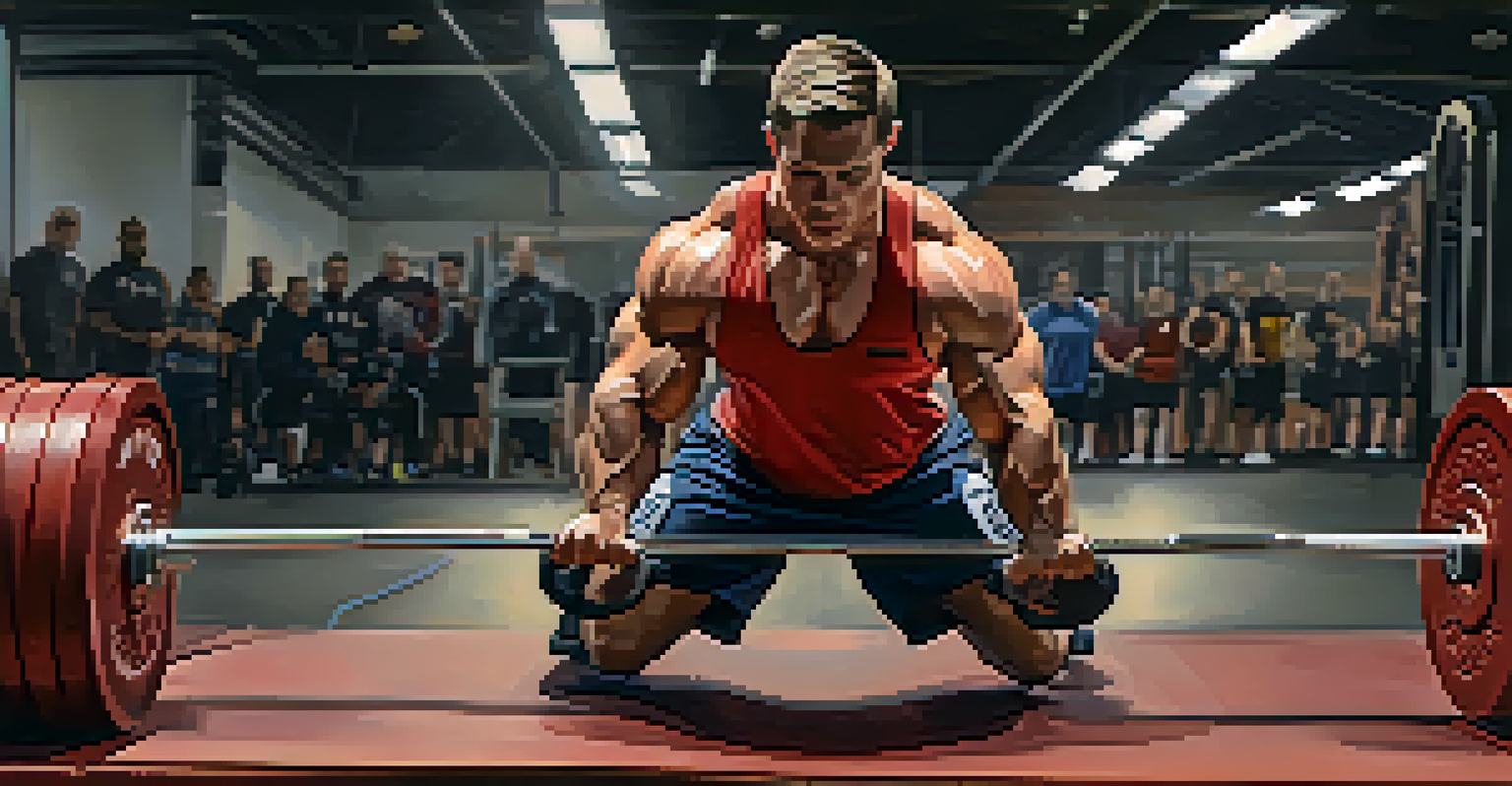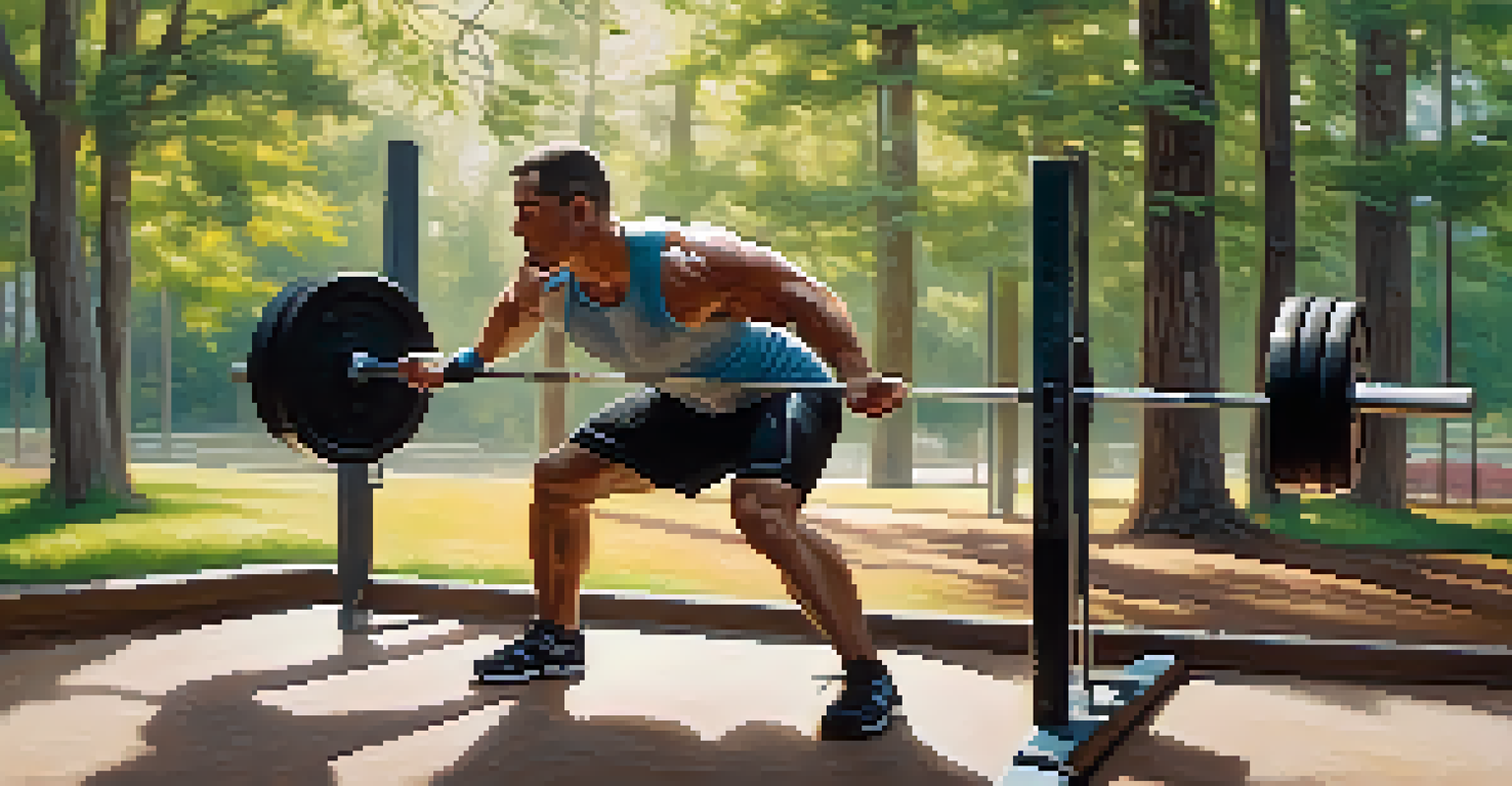Utilizing Dynamic Stretching for Injury Prevention in Powerlifting

Understanding Dynamic Stretching and Its Benefits
Dynamic stretching involves moving parts of your body through a full range of motion, unlike static stretching, which holds a position. This movement prepares your muscles for the demands of powerlifting by increasing blood flow and enhancing flexibility. By incorporating dynamic stretches into your warm-up routine, you can significantly improve your performance while reducing the risk of injury.
Dynamic stretching prepares the body for exercise by increasing blood flow and improving flexibility.
For powerlifters, where strength and stability are crucial, dynamic stretching helps activate the muscles that will be used during lifts. For instance, leg swings and arm circles can engage the hips and shoulders, preparing them for heavy squats and deadlifts. This preparation is essential because it not only warms up the muscles but also primes the central nervous system for optimal performance.
Overall, dynamic stretching serves as an effective tool to enhance mobility and improve your lifting technique. By integrating it into your routine, you create a solid foundation for your workouts, helping you stay injury-free and perform at your best.
Key Dynamic Stretches for Powerlifters
Incorporating specific dynamic stretches can greatly benefit powerlifters. Popular options include leg swings, walking lunges, and torso twists, which target the major muscle groups involved in lifting. For example, leg swings help loosen the hip flexors, making it easier to achieve depth in your squat.

Another effective stretch is the walking lunge with a twist, which not only activates your legs but also engages your core and upper body. This full-body movement mimics the action of lifting while improving your range of motion. Adding these stretches to your warm-up routine can enhance your overall performance.
Dynamic Stretching Prepares Muscles
Dynamic stretching enhances flexibility and warms up muscles, reducing injury risk during powerlifting.
Remember, the key is to perform these stretches in a controlled manner, aiming for 10-15 repetitions per movement. This approach will help you develop strength and flexibility simultaneously, paving the way for successful lifts and reduced injury risk.
The Role of Warm-Up in Injury Prevention
A proper warm-up is crucial in any workout regimen, especially in powerlifting. It prepares your body for the physical demands of lifting heavy weights, reducing the likelihood of strains or tears. Dynamic stretching should be a fundamental part of this warm-up, helping to increase your heart rate and activate muscle groups.
Listening to your body is crucial; it helps prevent injuries and enhances your overall training experience.
Skipping the warm-up can lead to injuries that not only sideline your training but can also lead to long-term damage. Think of your muscles as rubber bands; if they're cold and stiff, they’re more likely to snap under pressure. Conversely, warming them up with dynamic stretches makes them pliable and ready for action.
Ultimately, a well-structured warm-up routine that includes dynamic stretching can significantly enhance your lifting experience. It not only helps you lift more efficiently but also fosters a safer environment for your workouts.
Incorporating Dynamic Stretching into Your Routine
To effectively incorporate dynamic stretching into your routine, aim for a dedicated warm-up session of about 10-15 minutes. Start with light aerobic exercises, such as jogging or cycling, to elevate your heart rate before moving on to dynamic stretches. This combination primes your body for the intense lifting that follows.
Consider creating a stretching circuit that includes various dynamic movements targeting your specific lifting needs. For example, if you’re focusing on squats, include stretches that engage your hips, glutes, and quadriceps. By tailoring your warm-up to your workout, you ensure that your body is well-prepared.
Warm-Ups Prevent Injuries
A proper warm-up routine, including dynamic stretches, is essential for preventing strains and improving lifting performance.
Additionally, consistency is key. Make dynamic stretching a non-negotiable part of your training routine. Over time, you'll notice improvements in your flexibility, strength, and overall performance, helping you reach your powerlifting goals.
Common Mistakes in Dynamic Stretching
While dynamic stretching is beneficial, there are common mistakes that can hinder its effectiveness. One prevalent error is performing stretches too quickly or without control. This approach can lead to injuries rather than prevent them, as your muscles need time to adapt to the movement.
Another mistake is neglecting certain muscle groups. Powerlifting requires a full-body approach, so it's essential to include stretches that target all major muscle areas. For instance, focusing solely on your legs while ignoring your upper body can create imbalances and increase injury risk during lifts.
Lastly, avoid static stretching as part of your warm-up. Research shows that holding stretches can temporarily weaken muscles, which is counterproductive before heavy lifting. By steering clear of these mistakes, you can maximize the benefits of dynamic stretching.
Listening to Your Body: A Crucial Aspect
Listening to your body is vital when incorporating dynamic stretching into your powerlifting routine. Pay attention to how your muscles feel during stretches; if something doesn’t feel right, it’s essential to adjust your movements. Ignoring discomfort can lead to injuries that set you back in your training.
Moreover, remember that everyone’s body is different, and what works for one lifter may not work for another. If you find certain stretches uncomfortable or ineffective, don’t hesitate to modify them or explore alternatives. Flexibility and responsiveness to your body are key to a successful workout.
Consistency Enhances Performance
Regularly incorporating dynamic stretching into your training routine leads to better flexibility and overall lifting success.
Ultimately, developing a strong connection with your body can enhance your lifting experience. By being mindful of your physical sensations, you can make informed decisions that promote safety and effectiveness in your training.
The Long-Term Benefits of Dynamic Stretching
The long-term benefits of incorporating dynamic stretching into your powerlifting routine are substantial. Over time, consistent dynamic stretching can lead to improved flexibility, which is crucial for achieving optimal lifting positions. This enhanced flexibility not only aids performance but also contributes to overall joint health.
Additionally, dynamic stretching can help in muscle recovery. By promoting blood flow to the muscles, it aids in the removal of metabolic waste products, reducing soreness and stiffness post-workout. This means you'll be better prepared for your next training session, allowing you to progress more effectively.

Ultimately, the commitment to dynamic stretching pays off in the form of injury prevention, improved performance, and enhanced overall fitness. By prioritizing this practice, you set yourself up for long-term success in the world of powerlifting.